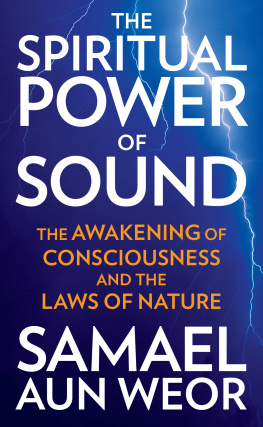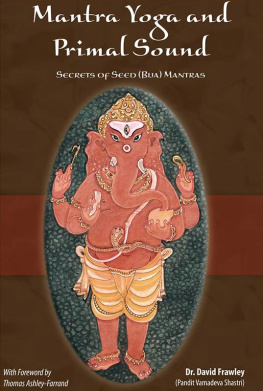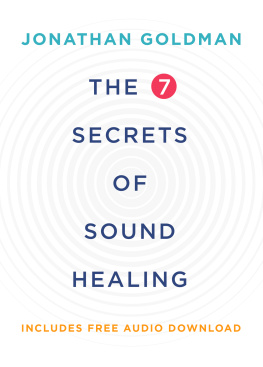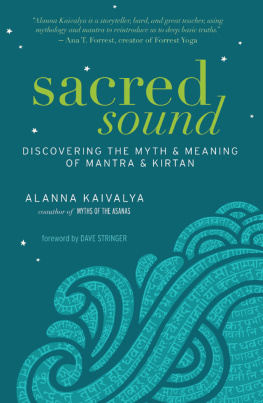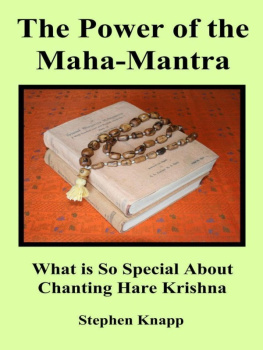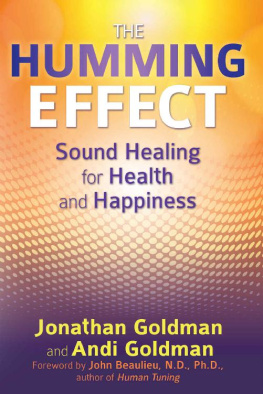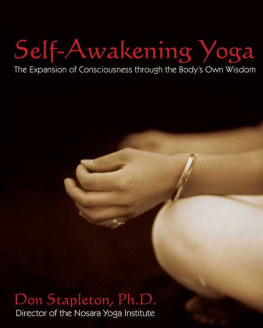THE
YOGA
OF
SOUND


Copyright 2004 by Russill Paul
All rights reserved. This book may not be reproduced in whole or in part, stored in a retrieval system, or transmitted in any form or by any means electronic, mechanical, or other without written permission from the publisher, except by a reviewer, who may quote brief passages in a review.
The material in this book and the accompanying audio tracks is intended for education. It is not meant to take the place of diagnosis and treatment by a qualified medical practitioner or therapist. No expressed or implied guarantee as to the effects of the use of the recommendations can be given nor liability taken.
Text design: Cathey Flickinger
Kundalini illustration on page 86 used with permission of the Joseph Campbell Foundation (www.jcf.org).
Cover photo of Insight Yoga Studio, Pasadena, California
Library of Congress Cataloging-in-Publication Data
Paul, Russill.
The yoga of sound : tapping the hidden power of music and chant / Russill Paul.
p. cm.
Includes bibliographical references and index.
ISBN: 978-1-57731-536-0 (alk. paper)
1. SoundReligious aspectsHinduism. 2. Yoga. 3. Mantras. I. Title.
BL1215.S67P38 2004
First paperback edition, April 2006
Originally published in hardcover in June 2004
ISBN: 978-1-57731-536-0
Printed in Canada on acid-free, partially recycled paper
Distributed to the trade by Publishers Group West
10 9 8 7 6 5 4 3

CONTENTS
PART 1: YOGA
A way of harmony, balance, and ecstasy
PART 2: MANTRA
The soul of yoga
PART 3: TRADITION
The four major streams of sacred sound in Hinduism
PART 4: PRACTICE
The elements of Sound Yoga
PART 5: INTEGRATION
Living the life of a sound yogi
To Bede Griffiths, 19061993,
my spiritual father, mentor, and dear friend.
Your love and light shine through this work.

C ertain forms of music, like beautiful fragrances, awaken associations in us that are primordial, eternal, and ultimate. These timeless associations call us to the core of our spiritual being. They address something in us that cannot die or be corrupted, a yearning that reaches out to the infinite. This is sonic mysticism, a reality we can all encounter in our lives if we open ourselves to the experience. Sonic mysticism is the spirituality of sound expressing the Divine Reality. The Sufis say that some music grants us a faint experience of God, an echo of divine reality and presence. The Hindu tradition, in its practical understanding of sound in the mystical life, tells us that music is God when it reaches its ultimate purity, focus, and effectiveness in opening the heart, mind, and spirit.
Music and sound permeate the cosmos perhaps all universes and realms, including Heaven itself. Experiments in the physics of acoustics have demonstrated that sound affects reality by actually creating structure. Using radio telescopes, astronomers have found sound throughout every corner of the universe. They have also discovered that some of the haunting sounds that inspire our most sacred music in many traditions are actually cosmic sonic elements, the sounds of the universe itself. This astounding discovery suggests how intimately we are connected with the cosmic matrix, and how deeply it affects us all.
It is also clear from consciousness studies that music, chant, and sound have direct and dramatic effects on consciousness. It doesnt take much to realize how profound a role music often plays in our lives. The sonic principle is indispensable to the full development of the human, particularly in relation to the mystical journey the moral, intellectual, psychological, and spiritual evolution of individuals, communities, nations, and the entire human family.
An angel holding a violin once appeared to St. Francis of Assisi. As the angel ran the bow very slowly over the strings, the heavenly music emanating from the instrument sent the saint into an intense ecstasy. Many of us have had similar mystical experiences. I remember listening to an angelic piece of music by David Hykess Harmonic Choir. Having received the CD as a Christmas gift, I opened it just before retiring one evening and reclined in my favorite chair. I cannot say what happened, except that it propelled me to a mystical state that is impossible to describe. It literally took me beyond this world! Such is the spiritual power of music.
Russill Pauls The Yoga of Sound relates to these experiences, but really it is an entirely unique work in a class all its own. There are hundreds of books on yoga, and some of them are outstanding, but this book is a pioneering achievement in sonic mysticism. Russill has been my dear friend for many years. We shared a common spiritual guide in Bede Griffiths, and we first developed our friendship in the monsastic community of Shantivanam ashram in south India eighteen years ago. We continue to enjoy a spiritual brotherhood through collaborative practice and teaching into the present day.
Knowing him as I do, I will not hesitate to identify Russill as a musical and spiritual genius, and this book is evidence of his gifts. Coming from the Indian tradition of Sound Yoga, a decisively contemplative means of achieving integration with the Divine, Russills writing and work stand on the shoulders of giants going back thousands of years. No other tradition has gone further, deeper, and higher than the Indian in exploring sound as a mystical method of union with the Absolute. This entire Indian body of spiritual wisdom has many strands. The West has embraced the physical strand of Hatha Yoga, but most of the other strands remain unknown in the West. This brilliant but very accessible and practical book illuminates not only the sonic element but how the many strands of yoga tradition fit together.
As a master of sonic mysticism, Russill has developed his own synthesis of this profoundly rich and effective tradition. He has assimilated this tradition through his intense study and contemplative life, and he has discovered a way to articulate it in terms intelligible to Western culture. Russill makes a very persuasive case for incorporating this sonic science into the Western practice of yoga. This is a remarkable achievement, and one that didnt come easy. Russills understanding of the needs of the American culture and its great diversity, along with his knowledge of how much this sonic dimension can enrich our culture, have been his constant motivations. He has given us the gift of Sound Yoga as a spiritual practice, until now a barely discovered means to enlightenment.
Samadhi, one of the goals of the Yoga of Sound, is an infinite, pure consciousness that transcends the vagaries of time. This pure consciousness, the nondual reality we all share as our deeper nature, is the destiny of sonic mysticism. In bringing about this emergence into pure consciousness, the Yoga of Sound, as Russill points out, is an alchemy of the soul. Although this practice will facilitate healing and relaxation, Russill shows us that arriving at, and dwelling in, pure consciousness is its final purpose. This purpose requires us to know the fullness of immortal, pure, and immutable consciousness our common ground and the basis of our reality.


